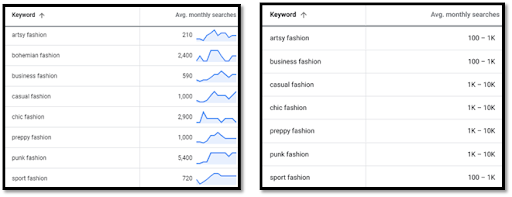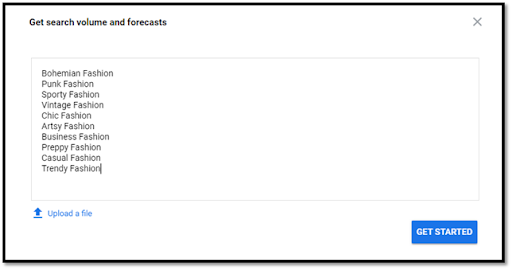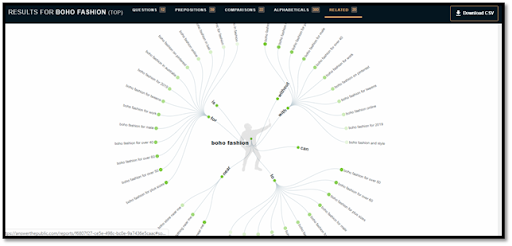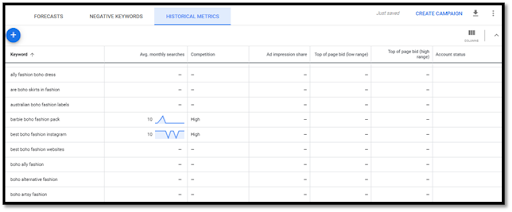30-second summary:
- Most SEOs use average monthly search volume, however, there are many other approaches and tools that can take your keyword research a few steps further. One of those tools is the Google Ads Keyword Planner.
- Using the Keyword Planner, we can see the monthly search volume – not just averages – all the way back to 2016, practically the middle ages in SEO years. This data is a virtual time machine, revealing seasonality of keywords and the ebb and flow of search interest over the years.
- A walk through a step-by-step guide of how to uncover and utilize search interest trends from Keyword Planner. This approach to keyword research and strategy is designed to be versatile, no matter the topic.
Most SEOs use average monthly search volume as the basis for their keyword research and as the starting point for their keyword strategy. This is a logical place to start since the data is easily accessible through your SEO platform of choice. However, there are many other approaches and tools that can take your keyword research a few steps further. One of those tools is the Google Ads Keyword Planner.
Here I’ll explain how SEOs can use the Keyword Planner’s historical insights to gain an understanding of emerging, declining, and trending topics to help build a more informed keyword strategy.
Google Ads Keyword Planner: The basics
Google provides an up-to-date and historic keyword search volume through the Google Ads – formerly AdWords – Keyword Planner. Near the beginning of each month, Keyword Planner populates the search volume for each keyword for the previous month. Using the Keyword Planner, we can see the monthly search volume – not just averages – all the way back to 2016, practically the middle ages in SEO years. This data is a virtual time machine, revealing seasonality of keywords and the ebb and flow of search interest over the years.
It’s important to note that unless there’s an active ad campaign in your account, the Keyword Planner provides ranges for monthly searches instead of specific numbers, making the data less useful.

However, assuming you have access to a Google Ads account with an active campaign (don’t be afraid to reach out to your paid search friends), the Keyword Planner can be used to better inform keyword strategy in two key areas:
- Search interest trends
- Emerging topics
Search interest trends
Through the Keyword Planner, you can compare search volume year-over-year to gain an understanding of which topics are trending or declining. That keyword that gets 50,000 monthly searches may be tempting, but looking at search volume history may reveal that its searches have been steadily declining for years. If the trend continues, it would seem silly in hindsight to target such a keyword.
Let’s use an example to walk through a step-by-step guide of how to uncover and utilize search interest trends from Keyword Planner. Imagine you are an online retailer looking to understand what types of fashion styles people are interested in.
To begin, here is a set of ten fashion-oriented keywords about to be inserted into keyword planner:

After you insert those keywords into Keyword Planner and click on the Historic Metrics report, a helpful graph of the total and mobile search volume over the past year appears.
You can then specify a custom date range – all the way back to 2016 if you wish.

The set of ten fashion keywords saw 45% growth in search volume in 2019 compared to 2018 – an increase of 62,070 additional clicks.
Below, you’ll find the list of 10 keywords with your typical metrics, including average search volume across the specified time frame.

This is all great, and many SEOs will stop their research here, but the real magic happens when you click the download icon next to “Create Campaign” and select “Plan Historical Metrics”. The download contains each keyword and the monthly search volume over the specified time period. Using this data, you can calculate the change in search interest in 2019 compared to 2018 at the keyword level.
| Keyword | Search Volume 2018 | Search Volume 2019 | YoY Difference | YoY Change | ||
| punk fashion | 25,300 | 56,200 | +30,900 | 122% | ||
| artsy fashion | 1,480 | 2,390 | +910 | 61% | ||
| preppy fashion | 7,230 | 10,950 | +3,720 | 51% | ||
| vintage fashion | 22,500 | 33,500 | +11,000 | 49% | ||
| chic fashion | 24,800 | 31,700 | +6,900 | 28% | ||
| casual fashion | 9,850 | 12,440 | +2,590 | 26% | ||
| business fashion | 5,680 | 7,120 | +1,440 | 25% | ||
| sport fashion | 7,470 | 9,340 | +1,870 | 25% | ||
| bohemian fashion | 23,700 | 26,800 | +3,100 | 13% | ||
| trendy fashion | 11,160 | 10,800 | -360 | -3% | ||
| Total: | 139,170 | 201,240 | +62,070 | 45% | ||
Handy Equations: =sum() to add each year’s search volume for the annual total. YoY Difference is the current year’s total minus the year prior’s. YoY Change is the Difference divided by the previous year’s total, multiplied 100.
Overall, this keyword set saw an impressive 45% increase in search interest in 2019 compared to 2018. Looks like a great time to be in the fashion industry.
“Punk fashion” leads the way in increased search interest. Its search volume more than doubled from 2018 to 2019. Who said punk was dead?
The artsy, preppy, and vintage keywords also saw strong gains, while the remaining keywords experienced modest growth. The only term to see a decline in search interest was for “trendy fashion”.
Now that we have the data, how do we turn it into actionable insights?
Insights influencing strategy
- Create new content: “Punk fashion” saw a massive uptick in search interest this past year. If your brand has products that fit into the punk genre, it would make sense to prioritize producing content – articles, videos, interviews, photo galleries, and similar ones – about punk fashion. Based on your product offering, it would also make sense to prioritize artsy, preppy, and vintage fashion content as they too have strong growth rates.
- Optimize existing content: The data supports prioritizing optimization of product and category pages related to punk fashion. With business goals and relevant products in mind, go down the list and prioritize sections of your site to optimize by growth opportunity.
- Build out new categories: Who knew there was so much interest in preppy fashion? Maybe your fashion ecommerce site doesn’t even have that as a category despite having product lines that fit that description. If so, now would be the perfect time to build out a category page to better take advantage of increased search interest.
Now that we have discovered trends on more general topics, let’s dig a bit deeper to uncover emerging topics for a specific category.
Identifying emerging topics
This approach to keyword research and strategy is designed to be versatile, no matter the topic. We can take any of the above fashion categories and dive deeper to uncover specific trending and declining topics within the category. Let’s jump right in, exploring all the related topics for the boho fashion category.
Gather the keywords
Take your topic and input it into your favourite keyword research database. As an example, I’m using Answer the Public, which is a database of Google Auto Complete queries. Not only does Answer the Public give an extensive list of search terms, it generally is much more comprehensive than your standard keyword database and everything is neatly downloadable into CSV format. Even better, Answer the Public is free, though it does limit you to three queries per day.

Look at all those keyword ideas – 468 to be exact – all on the niche subject of boho fashion.
Next step is to input those keywords into the keyword planner.

Keyword planner does some heavy lifting of pruning the massive list of keyword ideas for you. We’re left with 119 content ideas. All in all, these 119 keywords saw a combined 67,820 searches in 2019, a 31% increase over 2018.

Now you need to prune the list a little further. As with any keyword research tool, you’ll find plenty of irrelevant, duplicate or incomplete keywords that you’ll want to discard.
After pruning the list, you’ll have the meat of what you want to analyze. Using some simple spreadsheet formulas, we can easily compare search interest to the year prior.
Emerging topics
Emerging topics are the keywords that saw zero search volume the year prior, but now are receiving some interest. Note that all of these keywords have low search volume. That’s a good thing.
These are likely topics that other sites are not targeting. Being one of the first to produce content for these topics will put your site in a very competitive position from the start. If search interest continues to climb, you’ll be in a great position to benefit from that traffic.
| Keyword | Search Volume 2018 | Search Volume 2019 | YoY Difference |
| fashion boho cotton scarf leaf pattern | 0 | 190 | +190 |
| boho minimalist fashion | 0 | 180 | +180 |
| boho fashion rings | 0 | 160 | +160 |
| boho fashion for over 60 | 0 | 100 | +100 |
| boho fashion studio | 0 | 90 | +90 |
| boho fashion earrings | 0 | 80 | +80 |
| edgy boho fashion | 0 | 70 | +70 |
| when did boho fashion start | 0 | 50 | +50 |
| boho fashion quotes | 0 | 40 | +40 |
| boho fashion vintage | 0 | 20 | +20 |
| Total: | 0 | 980 | +980 |
These emerging terms are great topics for new content – be that articles, videos or an ecommerce page. What is most interesting for the boho fashion results are all the sub-categories, that is, minimalist, edgy and vintage versions of the boho look. This is great inspiration for new category pages or a blog post capturing these sub-categories.
Same goes for rings and earrings. If your ecommerce store offers these types of items and you don’t have a dedicated category covering these terms, now is the perfect time to build them out.
“Boho fashion quotes” and “when did boho fashion start” could also make excellent articles.
Topics with high growth
You should also analyze the terms seeing the most growth in general, even if they saw some search volume last year.
While there might be more competition for these terms, the growth in search interest makes them viable candidates for content creation.
| Keyword | Search Volume 2018 | Search Volume 2019 | YoY Difference | YoY Change |
| boho goth fashion | 50 | 180 | 130 | 260% |
| boho fashion mens | 120 | 260 | 140 | 117% |
| boho fall fashion | 410 | 850 | 440 | 107% |
| boho chic fashion | 1,430 | 2,400 | 970 | 68% |
| boho teenage fashion | 110 | 180 | 70 | 64% |
| boho maternity fashion | 100 | 140 | 40 | 40% |
| boho festival fashion | 130 | 180 | 50 | 38% |
| boho retro fashion | 80 | 110 | 30 | 38% |
| celebrity boho fashion | 80 | 110 | 30 | 38% |
| plus size boho fashion | 1,320 | 1,800 | 480 | 36% |
| Total: | 3,830 | 6,210 | 2,380 | 62% |
The topics with high growth provide a wealth of ideas for new sub-categories and articles. You could Target “boho fall fashion” with a boho fall fashion guide. Or, you could turn “boho fashion mens” into a new category for men’s boho fashion items. “Boho maternity fashion” might also make for a great article based on your products. Your imagination is the limit here.
Declining topics
This approach doesn’t just provide content ideas. It also allows for the intuitive prioritization of them. Through the Keyword Planner, you can identify the topics receiving less overall interest. These are the topics that should be deprioritized or avoided for upcoming content or optimization schedules.
| Keyword | Search Volume 2018 | Search Volume 2019 | YoY Difference | YoY Change |
| boho fashion dresses | 260 | 250 | -10 | -4% |
| japanese boho fashion | 130 | 120 | -10 | -8% |
| boho fashion wholesale | 210 | 190 | -20 | -10% |
| boho beach fashion | 150 | 130 | -20 | -13% |
| boho fashion tops | 200 | 170 | -30 | -15% |
| boho fashion accessories | 110 | 90 | -20 | -18% |
| boho folk fashion | 40 | 30 | -10 | -25% |
| urban boho fashion | 230 | 120 | -110 | -48% |
| boho fashion designers | 290 | 150 | -140 | -48% |
| boho luxe fashion | 200 | 80 | -120 | -60% |
| Total: | 1,820 | 1,330 | -490 | -27% |
In our current example, it would be prudent to de-prioritize writing a guide for “boho beach fashion” or hold off on creating a wholesale section for “boho products”.
Trends uncovered
Use cases for the Google Keyword Planner and platforms like Answer the Public extend far beyond the context of boho fashion. The techniques shared in this article can be utilized by any industry to uncover emerging and trending keywords related to virtually any topic.
There are, of course, limitations. Just because a keyword is currently trending, does not mean it will continue to do so. Also, Google’s search volume metric is not exact. Google rounds their numbers and is also likely under-reporting on actual search volume. However, Google’s data is likely the best insight we have on actual overall search trends.
Ultimately, this approach is meant to empower you to incorporate additional insight into the keyword research process. It provides dynamic data instead of relying on static average search volume. Not only does it reveal lots of great content opportunities, but it can also help you make keyword prioritization decisions that are supported by actual data and analysis.
Brad McCourt is an Organic Search Manager at Catalyst’s Boston office.
The post Keyword research guide: Using Google Keyword Planner’s historical insights to identify emerging and trending topics appeared first on Search Engine Watch.
from SEO – Search Engine Watch https://ift.tt/3b6pC7R
via IFTTT

No comments:
Post a Comment